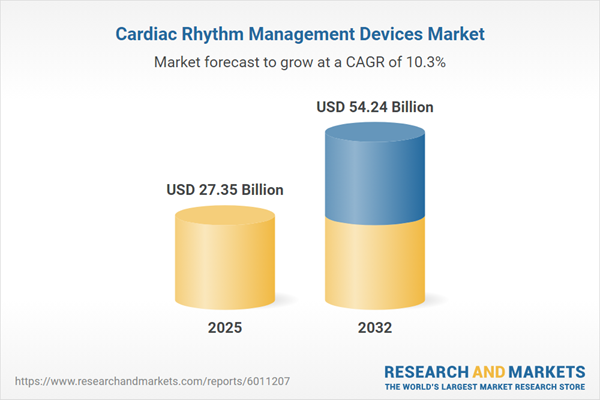Speak directly to the analyst to clarify any post sales queries you may have.
The cardiac rhythm management devices market is undergoing rapid transformation, driven by continuous medical innovation, expanded digital integration, and evolving healthcare delivery models. For senior decision-makers, maintaining clarity on these industry shifts is essential for strategic planning and operational success.
Market Snapshot: Cardiac Rhythm Management Devices Market
The cardiac rhythm management devices market attained a value of USD 24.80 billion in 2024. Growth is projected to continue, with expectations reaching USD 27.35 billion in 2025, reflecting a compound annual growth rate of 10.27%. By 2032, forecasts indicate the market will achieve USD 54.24 billion. Advances in arrhythmia and heart failure therapies, expanded adoption of digital health platforms, and a wider selection of device options drive this trajectory. Healthcare providers are adopting enhanced digital workflows and intelligent patient-centric solutions, supporting improved clinical outcomes across diverse care environments.
Scope & Segmentation of the Cardiac Rhythm Management Devices Market
- Product Segments: Cardiac resynchronization therapy devices, implantable cardioverter defibrillators, loop recorders, pacemakers (single, dual chamber, and leadless), as well as Holter and event monitors, address a broad spectrum of cardiac conditions.
- Therapy Modalities: Bradycardia pacing, multi-site pacing resynchronization, and defibrillation are key to comprehensive arrhythmia care for both acute and chronic cardiac patients.
- End Users: Hospitals, ambulatory surgical centers, and cardiac clinics deploy these devices for immediate interventions and long-term cardiac management adapted to each care setting.
- Clinical Indications: Devices target bradyarrhythmia, tachyarrhythmia, atrial fibrillation, ventricular tachycardia, and heart failure, ensuring continuity of care from diagnosis to follow-up.
- Lead Types: Traditional transvenous systems and emerging leadless technologies provide options for minimally invasive procedures and improved patient recovery experiences.
- Technologies: Features such as Bluetooth connectivity, wireless telemetry, MRI compatibility, and remote monitoring infrastructure enable clinicians to manage patients both at the bedside and remotely.
- Geographic Regions: Key markets include the Americas, Europe, Asia-Pacific, and Middle East & Africa, each shaped by local regulatory climates, adoption rates, and healthcare infrastructure trends.
- Industry Players: Prominent contributors such as Medtronic plc, Abbott Laboratories, Boston Scientific Corporation, Biotronik SE & Co. KG, MicroPort Scientific Corporation, LivaNova PLC, Lepu Medical Technology, Baxter, GE HealthCare, and ACS Diagnostics represent a competitive industry landscape.
Key Takeaways for Senior Decision-Makers
- Personalized treatment is advancing, integrating real-time patient monitoring, robust analytics, and connected digital workflows to drive clinical efficiency.
- Collaboration among medical device providers, telehealth platforms, and clinical organizations increases access to advanced therapies and enhances care coordination.
- Maintaining high standards of data security and system interoperability is necessary for regulatory compliance and to mitigate operational risks during device implementation.
- Regional sourcing and localized manufacturing contribute to flexible and resilient supply chains, enabling companies to respond to changing global trade conditions.
- Innovation in device size, power efficiency, and user interface is facilitating greater use in a range of healthcare environments and aligning with shifting models of cardiac care delivery.
- Streamlined regulatory processes and clear articulation of clinical value support consistent market adoption and informed investment decisions.
Tariff Impact on Supply and Sourcing
Recent U.S. tariff changes affecting critical components have led organizations in the cardiac rhythm management devices market to refine their sourcing and production approaches. Companies are emphasizing domestic manufacturing and developing new supplier relationships to maintain compliance and consistent product supply, irrespective of international trade dynamics.
Methodology & Data Sources
This market intelligence is informed by feedback from electrophysiologists, healthcare executives, and industry figures. Data synthesis includes peer-reviewed research, regulatory documents, and domain-specific analytics, ensuring strategic value for senior leaders.
Why This Report Matters
- Enables executive teams to optimize technology investment and risk management in the cardiac rhythm management devices market.
- Clarifies how regional, technological, and regulatory factors impact decision-making, allowing for targeted resource deployment and compliance.
- Supports organizations in responding proactively to shifting market and regulatory landscapes, strengthening operational agility and competitive standing.
Conclusion
This report provides actionable intelligence for executives aiming to adapt strategies and drive improved outcomes within the cardiac rhythm management landscape. Leveraging these insights reinforces operational planning and enhances patient care quality.
Additional Product Information:
- Purchase of this report includes 1 year online access with quarterly updates.
- This report can be updated on request. Please contact our Customer Experience team using the Ask a Question widget on our website.
Table of Contents
3. Executive Summary
4. Market Overview
7. Cumulative Impact of Artificial Intelligence 2025
Companies Mentioned
The companies profiled in this Cardiac Rhythm Management Devices market report include:- Medtronic plc
- Abbott Laboratories
- Boston Scientific Corporation
- Biotronik SE & Co. KG
- MicroPort Scientific Corporation
- LivaNova PLC
- Lepu Medical Technology Co., Ltd
- Baxter
- GE HealthCare
- ACS Diagnostics
Table Information
| Report Attribute | Details |
|---|---|
| No. of Pages | 180 |
| Published | October 2025 |
| Forecast Period | 2025 - 2032 |
| Estimated Market Value ( USD | $ 27.35 Billion |
| Forecasted Market Value ( USD | $ 54.24 Billion |
| Compound Annual Growth Rate | 10.2% |
| Regions Covered | Global |
| No. of Companies Mentioned | 11 |









